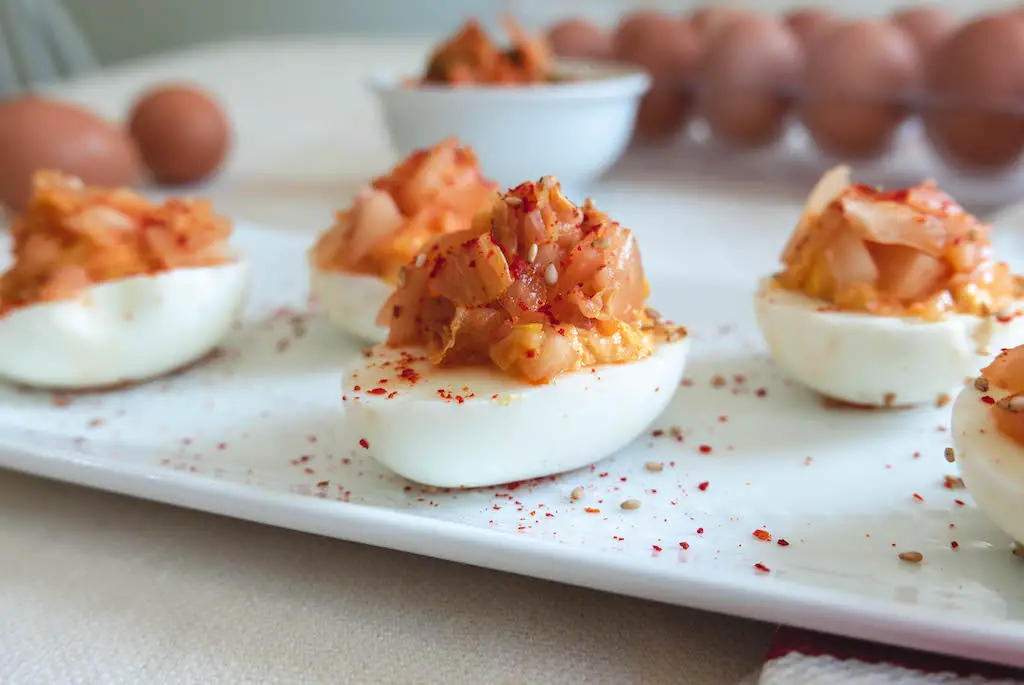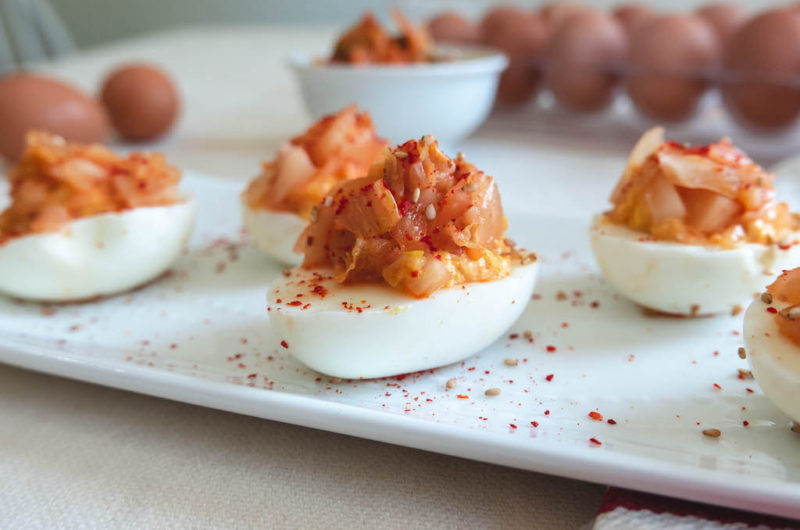This post may contain affiliate links. Please read my disclosure for details at the bottom of this page. As an Amazon Associate, I earn from qualifying purchases on this kimchi deviled eggs recipe. We hope you enjoy learning how to make these Korean deviled eggs!
Growing up in the south, we always shared deviled eggs during major family holidays such as Easter or Christmas. Because these delicious bite-sized treats are a favorite in my family, it was one of the first southern foods I introduced to my husband when we started dating. Coming from South Korea, he had never heard of or tasted deviled eggs before that point. Now, as a blended international family, my husband and I developed this kimchi deviled eggs recipe as a Korean Southern fusion dish!
We took one of my favorite southern spring recipes and combined it with traditional Korean flavors. The outcome is a delicious fusion of our two cultures! We hope you enjoy this recipe!
What Are Deviled Eggs?
Deviled eggs, also known as stuffed eggs or dressed eggs, are a type of finger food made from hard-boiled eggs. Once hard-boiled, you then shell, half, and fill the egg whites with a mixture made from the egg yolk and other ingredients such as mayonnaise, mustard, paprika, and more. Generally, southerners serve deviled eggs either cold or at room temperature.
If you try making deviled eggs, you will soon have the perfect appetizer or side dish to serve during potlucks, holidays, picnics, and family gatherings! You can try making our classic southern-style deviled eggs or our kimchi deviled eggs recipe below!
What Do I Need to Make Kimchi Deviled Eggs?
One of the best parts of this kimchi deviled eggs recipe, as well as our southern deviled eggs recipe I shared in the past, is that it requires just a few simple ingredients that are easily accessible at most grocery stores.

Below, we listed all the ingredients you need for this recipe:
- Mayonnaise, Gochujang, Sesame Oil: For the filling. If you need gluten-free or soy-free gochujang for this recipe, you can check out our recommendations via our ‘Gluten-Free Gochujang Brands’ article.
- Kimchi, Sesame Seeds, and Gochugaru: For the Garnish: If you do not have access to gochugaru (Korean red pepper powder), we recommend using paprika or cayenne. Gochugaru can now sometimes be found in the Asian section of the grocery store, in small amounts in the spice aisle, at Asian grocery stores, or online!
For those new to Korean ingredients, you can find the explanation of kimchi and gochujang below! These are affiliate links to share products we love!
What Is Kimchi? Where Do I Buy It?
Kimchi is a traditional Korean side dish (banchan) made by fermenting different types of vegetables, such as napa cabbage or radish.
In South Korea, there are hundreds of varieties of kimchi made with different fermenting methods and vegetables.
Examples of Different Types of Kimchi:
- Baechu Kimchi: Spicy napa cabbage kimchi
- Pa Kimchi: Green onion kimchi
- Kkakdugi: Spicy cubed radish kimchi
- Baek Kimchi: Otherwise known as ‘white’ kimchi, made without the spicy gochugaru
- Oi Sobagi: Cucumber kimchi; and more…
For this recipe, we will use the most famous and popular version of kimchi–baechu kimchi (배추김치). For reference, people in Korea make this kimchi by first soaking the napa cabbage in a salt brine. Then, they ferment the napa cabbage in a paste made of gochugaru (Korean spicy red pepper powder) and other ingredients.
Where Can I Buy Kimchi?
Nowadays, kimchi is readily available at many grocery stores in the refrigerated section. Though that is the case, if you have access to an Asian grocery store, you will find a much larger array of different types of kimchi as well as more authentic kimchi flavors.
For this recipe, we recommend buying kimchi that is fresher–check the different containers for later ‘best by’ dates. Kimchi, even after packaged and sent to the grocery store, continues to ferment. Newly-made kimchi is perfect for a side dish at the table and in this recipe. Order kimchi tastes stronger and sourer–it is best when fried with Korean barbecue or added into fried rice!

What Is Gochujang? Where Do I Buy It?
Gochujang is a Korean red pepper paste made by fermenting red pepper powder with glutinous rice, salt, and other ingredients until it becomes a thick, red paste. This paste tastes both savory and sweet with a bit of a spice kick.
Gochujang is an integral part of Korean cuisine. You will find it in ssamjang, a type of Korean barbecue dipping sauce. You may also find it in summer noodles such as bibimmyeon! Just know, if you plan on cooking a lot of Korean food, many recipes use gochujang, so we recommend investing in a few bottles!
Where Can I Buy Gochujang?
Like kimchi, gochujang has become readily available in many well-stocked grocery stores in recent years. If not available, you can find many brands in Asian markets or online.
Once again, for those who need to be gluten- or soy-free, look at our recommendations via our article about gluten-free gochujang brands! While you may not find allergen-free brands in your grocery store, you can often find different brands online!

Deviled Eggs Tips and Tricks:
- Like we stated in our southern deviled eggs recipe, J. Kenji López-Alt, the author of The Food Lab and a columnist with Serious Eats, tested how best to hard-boil an egg. He discovered that to make an egg easier to peel, you should start the egg in hot water (though this is not the case for soft-boiled eggs). You can read all of his research here.
- Then, to make the eggs easier to peel, directly transfer the boiled eggs from the pot to an ice bath. Let the eggs sit for approximately 10 minutes to let them cool. This allows the eggs to stop cooking on the inside and contract away from the shell.
- Use a food processor or blender to make the filling mixture. This ensures the mixture is creamy smooth and doesn’t have any lumps of egg yolk.
- We recommend using a piping bag to fill the egg whites with the yolk mixture. It is much easier than using a spoon! If you do not have a piping bag, use a plastic Ziplock bag and cut off the corner to make a homemade piping bag!

Deviled Eggs Frequently Asked Questions:
Below, we listed some questions you may have about these kimchi deviled eggs. If we do not answer your question, feel free to leave a comment or email us at [email protected]!
Can You Make Deviled Eggs in Advance?
Deviled eggs are best consumed the day they are made.
Though that is the case, you can make these kimchi deviled eggs no more than one day in advance.
How Long Can You Keep Deviled Eggs?
Deviled eggs should be kept chilled in the refrigerator unless you are serving them right away. After all, eggs are a perishable item.
Once refrigerated, deviled eggs can keep chilled for two to three days. Kept any longer, you run the chance of the eggs going bad. When storing the eggs, place them in an airtight container in a single layer.
You can also store and serve the eggs in a deviled egg tray. Often, these trays come with a lid for easy storage and transportation to potlucks and picnics. These are affiliate links to share products we love!
Did You Enjoy Our Kimchi Deviled Eggs Recipe?
In the end, do you enjoy eating Korean cold noodles? If so, let us know which is your favorite! Also, we would love to hear of any recommendations in the comment section!
If you would like to read more articles listing different types of Korean and Southern foods, check out the recipes below.
Southern Food and Drink Recipes:
- Southern Deviled Eggs
- Homemade, Fresh-Squeezed Lemonade
- Homemade Hot Pepper Jelly; and
- Southern Style (Lowcountry) Grits
Korean Food and Drink Recipes:
- Bibimmyeon (Spicy Korean Cold Noodles)
- Andong Jjimdak (Korean Braised Chicken)
- Mayak Eggs (Korean Marinated Eggs)
- Maneul Jangajji (Korean Pickled Garlic)
- Romaine Sangchu Geotjeori (Korean Romaine Lettuce Salad); and
- Soju Caipirinha (A Korean Take on Brazil’s National Drink)
If you have any questions or comments, you can also email us at [email protected].
And, finally, we would love to hear from you through our social media as well! You can follow us at @carvingajourney on Instagram, Twitter, Facebook, and Pinterest. Or, if you would like more articles like these, you can subscribe to our blog by joining our mailing list. We hope you enjoyed our kimchi deviled eggs recipe! Thank you so much for stopping by!
Carving A Journey is a participant in the Amazon Services LLC Associates Program, an affiliate advertising program designed to provide a means for sites to earn advertising fees by advertising and linking to Amazon.com. Although we may earn commissions for our endorsement, recommendation, testimonial, and/or link to any products or services from this website, these opinions are my own and I fully support these products.


